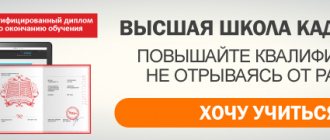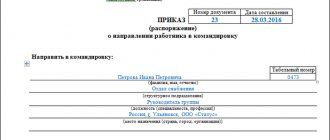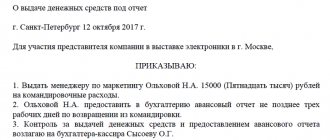_______________________________________ (name of company)
Order N ____
d. __________ “___”________ ___ d.
On approval of fuel consumption standards
and fuels and lubricants
In order to streamline the consumption of fuels and lubricants and confirm the validity of including in the income tax costs the cost of consumed fuel and fuels and lubricants (hereinafter referred to as fuels and lubricants), guided by the Order of the Ministry of Transport of the Russian Federation dated March 14, 2008 N AM-23-r “On the introduction The Methodological Recommendations “Standards for Consumption of Fuel and Lubricants in Road Transport” came into force,
I ORDER:
1. Set with “___”________ ___ g.
Sample order for approval of fuel consumption standards
AMUR REGION BELOGORSKY DISTRICT
dated October 01, 2020 No. 21
On approval of fuel consumption standards
and fuels and lubricants
In order to streamline the consumption of fuels and lubricants and confirm the validity of including in the income tax costs the cost of consumed fuel and fuels and lubricants (hereinafter referred to as fuels and lubricants), guided by the Order of the Ministry of Transport of the Russian Federation dated March 14, 2008 N AM-23-r “On the introduction The Methodological Recommendations “Standards for Consumption of Fuel and Lubricants in Road Transport” came into effect, as amended on July 14, 2015 No. NA-80-r
Briefly
- Waybills are used to draw up an act for writing off fuel and lubricants.
- Data from waybills allow you to write off fuel and lubricants both according to standards and actual fuel consumption.
- An organization can be guided by consumption standards approved by the Ministry of Transport, or it can develop its own economically sound consumption standards.
- Fuel consumption standards are approved by order of the head of the organization.
- Particular attention is paid to justifying expenses for tax accounting purposes.
Share: Facebook
- Previous entryAdministrative criminal liability
- Next entryDismissal of the CEO by decision of the founder
Order on approval of fuel and lubricants consumption standards
An order on fuel and lubricant consumption standards is a document that reflects the order of the head of the enterprise regarding fuel consumption standards, as well as fuels and lubricants for the operation of specific vehicles at the enterprise.
As a rule, certain types of fuel standards are established for general purpose vehicles. All standards take into account certain features, such as the carrying capacity of the vehicle, its operation with or without a load, with or without a trailer, the weight of the load, the condition of the vehicle, the route it takes, the design of the vehicle, its engine, type and category, as well as as well as a number of other factors.
To take into account operational, climatic, road transport, and other factors, correction factors are used. They are set in the form of an increase or decrease in the initial value of the fuel and lubricants consumption rate, expressed as a percentage.
But it should be borne in mind that when transporting a vehicle in a suburban area, there is no need to use correction factors.
It is in the order approving fuel and fuel consumption standards, which is signed by the head of the enterprise and indicates the specific value of the correction factor. In the future, data on consumption rates will be used in the fuel and lubricants accounting program, this will increase the speed of calculations and avoid errors.
Who publishes it and why is it needed?
This form of documentation should be understood as an administrative act issued by the management of a business entity. In accordance with the documentation, regulation is made of how settlement measures are carried out in relation to the cost of fuel and lubricants costs for write-off. This nuance may be factual or have normative significance.
According to standards, road transport companies calculate costs. As for other entities, they have the right to calculate expenses after the fact.
ORDER ON FUEL CONSUMPTION STANDARDS.
We also invite you to download on our resource the Methodological Recommendations AM-23r and the addition to them NA-50r. You can also find links to these two documents below. And now about the order itself.
The basis for a reasonable write-off of fuel consumption is not only the availability of the basic norm, which you found in the recommendations or ordered from us. The basis will be an internal document signed by the manager, which will specifically indicate the relevant data (more on this later). This document is called an order on fuel consumption standards.
ORDER ON FUEL CONSUMPTION STANDARDS. CONTENT.
There are two options here.
The first option is based on the Methodological Recommendations AM-23r and/or the addition to them of NA-50r and NA-80r.
Write-off order
As can be seen from the above, there can be many options and nuances for writing off fuel and lubricants based on vouchers. All of them must be reflected in the order for the write-off of fuel and lubricants. The document signed by the manager serves as a guide to action for the company's accountant and justifies the use of one or another write-off methodology and the use of correction factors. The order to write off fuel and lubricants does not have a unified form, but is drawn up according to general office work rules.
Sample order
Almaz LLC ORDER No. 3
Moscow
June 1, 2020
On establishing fuel consumption standards for passenger cars
I ORDER: 1. Set the diesel fuel consumption rate to:
- 21108 “Premier” (VAZ-21128) 9 liters per hour;
- Cyber 2.4 (Chrysler) 11 liters per hour.
2. From October 15 to April 15, increase the established standards by 11%. 3. Write off fuel and lubricants once a month according to the write-off act. 4. Appoint chief accountant A.I. Sidorova as responsible for execution.
Director of Almaz LLC: Petrovsky K.P. The order has been reviewed by: Chief Accountant Sidorova A.I.
How to use fuel consumption standards for 2020
It is necessary to determine the consumption of fuels and lubricants (fuels and lubricants) because they:
- are included in the cost of production costs (works, services) and are taken into account as other costs;
- influence the amount of income tax.
In 2020, enterprises and individual entrepreneurs can set their own standards, but you cannot write off any amount convenient for the company for fuel consumption. The tax office may ask you to justify the expenses. And this is where Minirance comes to the rescue.
They can serve for enterprises and private owners as a kind of approximate basis for calculating fuel consumption rates. In addition, if there is no particular need to set your own standards, it is quite possible to use the data of the Ministry of Transport.
It's quite convenient. Since, in addition to the standards, there are also recommendations for an additional factor that increases the cost of fuel and lubricants. The value of the coefficient depends on the region, time of year, and age of the vehicle.
Important! Firms that carry out their business within the framework of a management and control system, regardless of their form of ownership, and that use vehicles and rolling stock on automobile chassis within the Russian Federation, are required to use fuel consumption standards (in the latest edition) established by the Ministry of Transport in 2020.
This position was confirmed by the tax office in its letter dated September 21, 2015 No. AS-4-10/16581.
The Ministry of Transport approved its significance by order dated March 14, 2008 No. AM-23-r. Since then, the transport department has regularly made only amendments to this document. Basically, the amendments consist of expanding the list of cars used by companies and individual entrepreneurs within the borders of the Russian Federation.
The latest edition of the document is dated September 20, 2020, numbered No. AM-23-r.
Attention! If there is excessive consumption of fuel, oil or other materials, then save the waybills and include as much information as possible in them. This way you can justify your increased gasoline costs to the Federal Tax Service. You can also justify yourself with a certified report on fuel costs. The article “The correct waybill will justify the costs of fuel and lubricants and the driver’s salary” will help you prepare a waybill without errors.
Write-off of fuels and lubricants according to winter standards from what date
What standards to choose for the winter Start the transition to winter fuel consumption standards by deciding which standards - your own or official ones - the company will apply. When calculating income tax, expenses for the maintenance of vehicles, including fuel and lubricants, are not standardized (subclause 11, clause 1, article 264 of the Tax Code of the Russian Federation).
But there are advisory standards that are given in the Methodological Recommendations (Order of the Ministry of Transport of Russia dated March 14, 2008 No. AM-23-r). The recommended standards provide percentages by which the standard summer standards can be increased in the winter.
Standards for winter depend on the region of Russia. The percentages can be seen in the visual table below.
The value of winter surcharges to fuel consumption standards by region of Russia No. PP Regions of Russia (by federal districts) Number of months and validity period of winter surcharges Limit value of winter surcharges no more than, % 1 2 3 4 I.
The travel document form with a unified form was approved by a resolution of the State Statistics Committee. As a rule, it is issued for one day or a certain period of time, depending on the production activities of the enterprise. But its duration should not exceed a month.
Attention
It must indicate the remaining fuel, fuel consumption, information about mileage and route. Fuel consumption is determined based on the entries in the passenger car's waybill. It is the primary document that is used to keep records of its work.
Index number 3 and OKUD code 0345001 have been approved for it. As for the norm for writing off fuel and lubricants with gas equipment, you can set them yourself, guided by the standards approved by the Ministry of Transport.
Norms for writing off fuel and lubricants in 2020 in the Russian Federation
1 tbsp. 252 of the Tax Code of the Russian Federation). If the company decides to set its own standards, then the limits are by order of the head of the organization. They must correspond to the brands of cars, take into account their technical condition and operating features. See below for a sample order on fuel and lubricants standards.
New fuel consumption standards - how to write off more
If there are significant deviations in the direction of decreasing air temperature from the average statistical indicators, then it is necessary to coordinate the decision made by the legal entity with the local service of the Roshydrometcenter.
In the summer Some enterprise managers are wondering when they will switch to summer standards for writing off fuel and lubricants? As a rule, in summer, fuel consumption is commensurate with the basic norm, and in some cases, actual fuel consumption increases due to the use of a cooling system or air conditioning in the cabin. The cooling equipment in some vehicles requires a significant amount of fuel to operate. If a vehicle is equipped with a climate control system or air conditioning, then a legal entity can increase fuel consumption by 7-10% of the basic norm. The Ministry of Transport in its recommendations has provided correction factors for the summer period.
Application of winter surcharges to fuel consumption standards
As a temperature limit for the winter period, apply a steady decrease in the average daily ambient temperature by -50C and below. As a rule, the rate of write-off of fuel and lubricants for a particular season in the regions is approved on an individual basis. For the winter period it is set from October 1 to March 30.
According to the recommendations of the Ministry of Transport, the consumption rate of fuel and lubricants for the winter period must be increased by 5-20%, taking the climatic features of the region as the main prerequisites.
For example, in the city of Moscow from November 1 to March 31, the consumption rate increases by 10%, and in the Murmansk region by 15%.
Also, in accordance with the provisions of the methodological recommendations, a legal entity has the right to increase fuel consumption by 10% of the base rate for each hour of vehicle downtime, provided the engine is running. In this case, the vehicle is warmed up.
How to approve fuel consumption standards for 2020
To avoid showdowns and litigation with the tax authorities, assert your values in accordance with all the rules and reasonably. Although validity is a very delicate matter, since the law does not prohibit companies and individual entrepreneurs from using fuel at their discretion.
Increasing factors can also be used to justify fuel costs, so don’t forget about them.
For example , your car is 12 years old. Your company uses it in the southern highlands (2500 meters) in a city with a population of 300,000 people. Thus, in winter, you can increase the rate per 100 km by 5% - for the winter season in southern conditions; by 10% - regional coefficient; 15% - for landscape.
The fuel consumption rate in 2020 must be recorded in the manager’s order. The company decides for how long to draw up the order, based on the frequency of operating conditions of the machine.
It is not necessary to make an order annually; it is more advisable to develop seasonal ones, especially for regions with a pronounced winter-summer climate change. The order is drawn up in free form, but with the inclusion of mandatory parameters:
- Full name of the organization;
- Order number, date;
- The period for which the norm is established;
- Make of the vehicle and its registration number;
- Gasoline (diesel) consumption rate;
- Rationale;
- Signature of the manager with transcript.
Sample order
An order can include several vehicles at the same time. The order changes if the company purchased a new car, wrote off an old one, or operating conditions changed, leading to changes in fuel consumption.
If additional coefficients were used, then it is better to issue a separate order on them, focusing on the fuel consumption standards of the Ministry of Transport in the latest edition. That is, you seem to justify the increase in costs with regulatory documents. But in principle this is a safety measure, and you can do without it.
Based on the waybill (other documents), calculate the amount of fuel that is written off as expenses. To do this, use the formula:
Amount of fuel to be written off as expenses (l)
Calculation example
Let us use a conditional example to explain the procedure for writing off fuel according to waybills. Almaz LLC has a certain brand of gasoline in stock, 70 liters, at a price of 42 rubles. This month, 100 liters of fuel of the same brand were purchased at a price of 40 rubles, and 40 liters were dispensed. Fuel and lubricants are written off at average cost.
The average write-off value will be:
- 70 * 42 = 2940 rubles;
- 100 * 40 = 4000 rub.;
- 2940 4000 = 6940 rubles;
- 70 100 = 170 l;
- 6940 / 170 = 40.82 rubles.
Based on actual fuel consumption, costs are calculated as follows:
- The waybill shows the remaining fuel in the tank is 5 liters, 40 liters were filled, the remainder after the flight is 10 liters.
- Actual consumption: 5 40 - 10 = 35 l.
- Having assessed this expense according to the calculated cost, we obtain the cost of fuel and lubricants: 35 * 40.82 = 1428.70 rubles.
- Let the car be used for official purposes by the deputy director, then the costs will be written off Dt 26 Kt 10/3 for maintenance.
When calculating according to standards, the calculation formula is taken from document AM-23-R. The car, the waybills of which we took for the calculation, is a passenger car, the formula (p. 2, p. 7) will be as follows: Qн = 0.01 * Hs * S * (1 0.01 x D), where:
- D – correction factor in percentage established in the organization;
- S—mileage;
- Hs – consumption rate per 100 km.
We invite you to familiarize yourself with: Sample lease agreement for an indefinite period
Seasonal coefficient D (winter, increasing, reflecting increased gasoline consumption) is not applied. The consumption rate for this model is 8.8 l. The recorded speedometer readings when leaving were 2510, when returning - 2565.
Calculation:
- Mileage: 2565 - 2510 = 55 km.
- Flow: Qn = 0.01 * 8.8 * 55 * (1 0.01) = 0.01 * 8.8 * 55 * 1.01 = 0.01 * 484 * 1.01 = 4.84 * 1 .01 = 4.89 l.
- 4.89 * 40.82 = 199.61 rub.
- Wiring: Dt 26 Kt 10/3 199.61 rub.
Order on fuel and fuel consumption standards
An order on fuel and lubricant consumption standards is a document used to determine fuel and lubricant consumption standards, taking into account the make, modification of the vehicle, as well as the work performed by a specific vehicle.
Standards established for general purpose vehicles:
- the basic norm, expressed in liters per 100 km of vehicle mileage in running order (the indicator directly depends on the design of the vehicle, its category, units, purpose and type of vehicle, as well as directly on the fuel it uses);
- transport norm, expressed in liters (the indicator includes the basic norm and directly depends on the rated vehicle load, the mass of the transported cargo, taking into account the operating conditions of the vehicle);
- per 100 km of vehicle mileage performed for transport work;
- per 100 ton-kilometers of a truck performing transport work, taking into account a road train with or without a trailer (semi-trailer) containing cargo.
It should be borne in mind that when determining fuel and fuel consumption standards, it is necessary to take into account correction factors, the size of which depends on climatic, road transport and other operational factors. The basis for the order may be an act of control measurement of fuel consumption. The order must be approved by the immediate manager of the enterprise.
More on the topic::
- Order to introduce standards for fuels and lubricants Order to write off fuel In order to write off fuels and lubricants, it is necessary to confirm the nature of use of these reserves. The basis for writing off spent fuel and lubricants...
- Smirnov aa reference manual for the repair of instruments and... Smirnov aa reference manual for the repair of instruments and regulators Is a practical guide to the repair and adjustment of instruments and regulators of technological...
- Order on the appointment of those responsible for technical... Sample form of an order on the appointment of a person responsible for the safe operation and technical condition of vehicles (prepared by experts) Order...
- Fine for a waybill for a truck 2020 Fine for lack of a waybill in 2020 In order to figure out who needs a waybill and why, you should clearly...
- Sergeev in Patent Sergeev in Patent Home Register of patents Latest news (21), (22) Application: 2007149349/06, 12/29/2007 (24) Start date of the patent term:…
- Examination of Saratov oil Independent examination in Saratov center for independent examination and assessment What is independent examination Independent examination is a procedure carried out by competent and…
Norms for writing off fuel and lubricants - in winter and summer, for passenger cars
Any company in the course of its work uses vehicles that help speed up the production process.
For them to work in favor of the company, considerable funds are required, which are mainly spent on the purchase of fuels and lubricants. Large companies prefer to have a specialist on their staff who deals with issues regarding fuel and lubricants.
It makes a detailed calculation of fuel consumption based on an analysis of vehicle operation, sets consumption standards, and writes off fuel and lubricants.
What it is
The term “norm” means the amount of resource expenditure, which is determined on the basis of relevant standards, based on the organizational and technical conditions of work activity.
Standardization is a process that allows you to establish maximum permissible or optimal standard indicators.
As a rule, they are established taking into account the orders of the Ministry of Transport of the Russian Federation, international standards and rules, specific features of the field of production activity, type of vehicle, degree of wear, make and model.
The calculations are based on the actual volume of material consumed and compared with standard values, as a result of which the rate of consumption of hydrocarbons at the enterprise is established.
According to generally accepted rules, fuel consumption rationing involves the use of a basic fuel consumption indicator, which is determined individually for each model, brand or modification of a vehicle and a calculated indicator that takes into account the work performed by the vehicle and its operating conditions.
The company carries out the following types of activities to establish fuel consumption standards:
- an order is issued by the head of the company to measure the fuel consumption consumed by each vehicle;
- An act is drawn up based on the results of the measurements taken. Moreover, the act is drawn up separately for each vehicle that is registered with the company;
- appropriate calculations are carried out, after which the fuel consumption rate for each vehicle is established;
- A special regulation on fuel consumption standards is being developed, which includes the standards established by the company. The regulations are approved at a general meeting of the team in the presence of shareholders and founders.
According to the calculations carried out and established standards, the company writes off the amount of fuel consumed. The write-off procedure is documented in a corresponding act, which is under the jurisdiction of the material accountant.
Companies can rely entirely on the standards established by the Ministry of Transport and not have to deal with such extensive work.
Which, of course, is what medium and small companies and firms do. But large companies everywhere have their own fuel consumption and consumption standards.
Norms for writing off fuel and lubricants in winter
The Ministry of Transport has established fuel write-off standards taking into account road transport situations and factors directly related to natural and climatic conditions.
To take them into account, correction factors are used to increase or decrease the amount of fuel and lubricants consumed. For example, in some regions, fuel consumption in winter increases significantly in winter.
As a temperature limit for the winter period, apply a steady decrease in the average daily ambient temperature by -50C and below.
As a rule, the rate of write-off of fuel and lubricants for a particular season in the regions is approved on an individual basis. For the winter period it is set from October 1 to March 30.
According to the recommendations of the Ministry of Transport, the consumption rate of fuel and lubricants for the winter period must be increased by 5-20%, taking the climatic features of the region as the main prerequisites.
For example, in the city of Moscow from November 1 to March 31, the consumption rate increases by 10%, and in the Murmansk region by 15%.
Also, in accordance with the provisions of the methodological recommendations, a legal entity has the right to increase fuel consumption by 10% of the base rate for each hour of vehicle downtime, provided the engine is running.
In this case, the vehicle is warmed up. If there are significant deviations in the direction of decreasing air temperature from the average statistical indicators, then it is necessary to coordinate the decision made by the legal entity with the local service of the Roshydrometcenter.
Write-off of fuel and lubricants when using personal vehicles for business purposes is discussed on this page.
Some enterprise managers are wondering when they will switch to summer fuel write-off standards? As a rule, in summer, fuel consumption is commensurate with the basic norm, and in some cases, actual fuel consumption increases due to the use of a cooling system or air conditioning in the cabin.
The cooling equipment in some vehicles requires a significant amount of fuel to operate.
If the vehicle is equipped with a climate control system or air conditioning, then a legal entity can increase fuel consumption by 7-10% of the base rate.
The Ministry of Transport in its recommendations provided for correction factors for the summer period.
In accordance with its provisions, from April 1 to September 30, correction factors begin to be applied when determining expenses for summer time.
They are established based on the decision of the head of the enterprise, based on the service life and the availability of equipment installed in it.
The transition to the summer period for writing off fuel and lubricants, as well as to the winter period, is carried out according to the ambient temperature.
As a rule, with an average daily temperature of +50C, you can switch to the summer period. In both cases, the transition is formalized by issuing an appropriate order.
For passenger cars
In 2020, by order No. NA-50-r, the Ministry of Transport introduced amendments to update the consumption rate, according to which the cost of fuel and lubricants for passenger cars is written off.
The department has established standard indicators for popular cars that are not included in the above act. Write-off of fuel and lubricants is carried out on the basis of a waybill.
The travel document form with a unified form was approved by a resolution of the State Statistics Committee.
As a rule, it is issued for one day or a certain period of time, depending on the production activities of the enterprise.
But its duration should not exceed a month. It must indicate the remaining fuel, fuel consumption, information about mileage and route.
Fuel consumption is determined based on the entries in the passenger car's waybill. It is the primary document that is used to keep records of its work. Index number 3 and OKUD code 0345001 have been approved for it.
As for the norms for writing off fuel and lubricants with gas equipment, they can be established independently, guided by the standards approved by the Ministry of Transport.
Standards for cars that work:
- for liquefied petroleum gas, the norm is set in liters based on the calculation: 1 liter of gasoline is equivalent to 1.32 liters of LPG, that is, 1.22÷0.1. It depends on the properties of the propane-butane mixture;
- on compressed or so-called natural gas, it is measured in cubic meters at the rate of: 1 liter of gasoline - 1.0÷0.1 cubic meters. depending on the properties of natural gas.
If the vehicle is equipped with gas-diesel engines, then the consumption rate of compressed natural gas is measured in cubic meters.
In this case, the diesel fuel consumption rate in liters is indicated. Typically, the fuel ratio is set by the manufacturer that produced the vehicle.
And in conclusion, it should be noted that employers, with increasing prices for fuels and lubricants, are trying to control fuel consumption.
It is carried out with the aim of increasing the efficiency of the company's production activities while minimizing costs associated with the consumption of fuels and lubricants. The measure greatly contributes to the establishment of smooth operation of vehicles in the company.
Find a sample act for writing off fuel and lubricants here.
Read about bankruptcy of legal entities at the link.
Source: https://vkadry.com/normy-spisanija-gsm.html
Updating orders for the enterprise in the New Year
We’ll look at which ones exactly in our article.
This is perhaps the most important group of administrative documents regulating the activities of the company.
They cover all structural divisions and production areas without exception. They concern both accounting at the enterprise and ensuring the conduct of business activities, as well as personnel policy and payroll. The following orders are subject to mandatory updating:
- “On the appointment of a permanent audit commission for OS and;
- “On the procedure for carrying out inventory.”
- “On cash discipline”;
- “On accounting policies”;
Let's look at them in more detail.
The Order “On Accounting Policy” is created on the first working day of the new year.
Should the HR department issue an order to the organization to approve fuel consumption standards?
Thus, the consumption rates of fuel and lubricants are used when calculating income tax, as well as when accounting for fuel and lubricants, therefore, logically, they belong to the accounting department, or the administrative and economic part. Therefore, in our opinion, the order
“On approval of fuel consumption standards for official vehicles”
must be issued specifically to these departments.
However, it is also necessary to take into account the workflow in your organization. Therefore, if the Regulations on Office Work do not assign the responsibility for drawing up this order to anyone, then in order to avoid further misunderstandings, assign this responsibility to the responsible employee of the accounting department or the administrative and economic part (in accordance with your structure).
Sample order on approval of fuel and lubricant consumption standards for official vehicles Closed Joint Stock Company "Alpha" ORDER No. 11 on approval of fuel and lubricant consumption standards in the city.
Fuel and lubricants: income tax
And then adjust them using special coefficients taking into account the following factors:
- the vehicle is operated in winter or summer (summer fuel consumption rate and winter fuel consumption rate);
- a car drives in the city or in the countryside;
- Is air conditioning used in summer?
- whether there are special climatic conditions (snowfall, ice), etc.
Approval of fuel consumption rates is usually carried out by order of the head of the organization. 2) Taking into account increasing factors, approve fuel consumption standards:
- in winter – 23.7 l/100 km;
- in summer - 21.6 l/100 km.








